#1720s fashion
Text
Historically accurate Armando Salazar :) with a lazy background
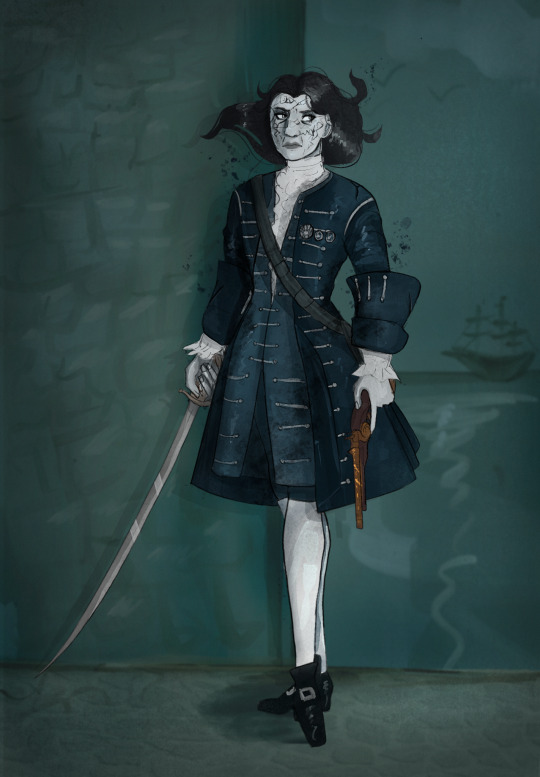
Research:
I keep trying to find military uniforms from the 1720s but, like I expected, no museums care about the first quarter of the 18th century so I sadly couldn’t find any references. I did however find this portrait with similar buttons to Armando’s coat:

And also used this illustration of Calico Jack from 1725 for inspiration!

I’ve never seen anyone roll up the cuffs of their coat like that, so I assume either it was the artist’s interpertation of what a pirate would do, or something like that. Either way I thought it was cool! I also gave him the shoulder gun-holster thing. On second thought I probably should have drawn him with multiple pistols, maybe?
I decided not to give Armando a wig so I could draw his beautiful hair. I can’t tell you if this is something pirate captains did or not because from what I’ve seen no one knows and I’ve seen illustrations with and without wigs.
Ok, that’s it! If I got anything wrong or you happen to know anything else about 1720-1730s fashion please tell me!
#potc#potc fanart#character design#18th century#pirates#historical fashion#historical#1720s#1720s fashion#pirates of the caribbean#pirate history#?#i don't remember his backstory maybe I should have looked that up#armando salazar#i do realize he looks 20 years old
57 notes
·
View notes
Text
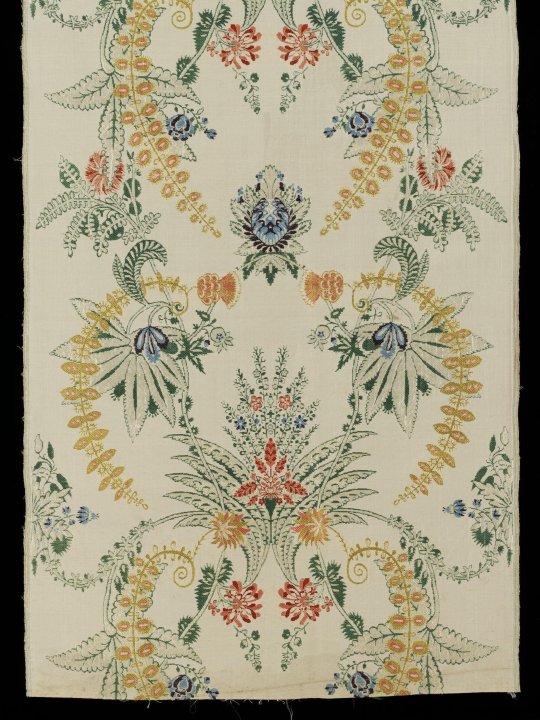
Dress fabric of brocaded silk, Spitalfields, London, 1724-1725
#18th century#18th century fashion#spitalfields silk#historical fashion#fashion history#silk#1720s#1720s fashion
34 notes
·
View notes
Text
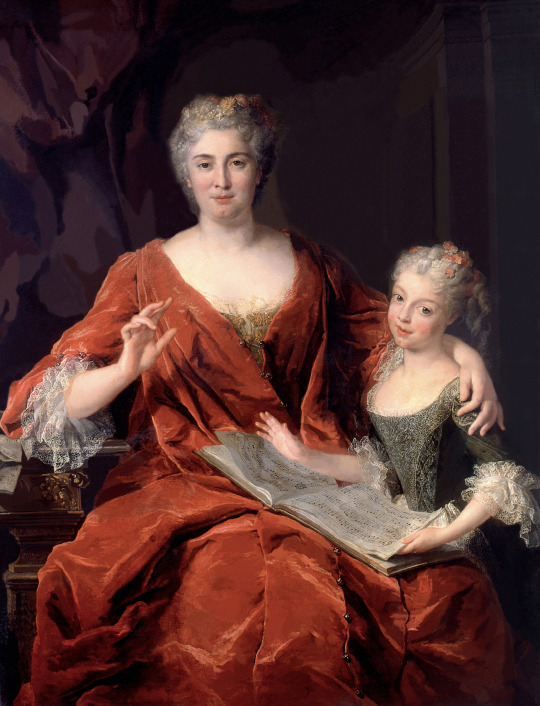
1724 Madame de La Sablonnière et de sa fille by Alexis-Simon Belle (Musée des Beaux-Arts de Pau - Pau, Pyrénées-Atlantiques, Nouvelle-Aquitaine, France). From pop.culture.gouv.fr-notice-mnr-MNR00087; fixed spots w Pshop 2781X3635. This one had many, many spots making it hard to determine what was in between them.
#1720s fashion#Louis XV fashion#Rococo fashion#Madame de La Sablonnière#Alexis-Simon Belle#robe volante#lace cuffs#modesty piece#stomacher
39 notes
·
View notes
Text
Early 18th (and late 17th) century fashions are so under-utilized in vampire media and I think it's a damn shame.
I don't actually think I've ever seen a single image of a vampire character in an early 18th century suit. Hardly any movies set in that era either, and hardly any historical costumers who do it.
(Even my beloved gay pirate show set in 1717 takes nearly all of its 18th century looks from the second half of the century. Not enough appreciation for baroque fashion!!)
Yes I love late 18th century fashion as much as anyone, and 19th century formal suits are all very well and good, but if you want something that says old, dead, wealthy, and slightly dishevelled, then the 1690's-1730's are where it's at.
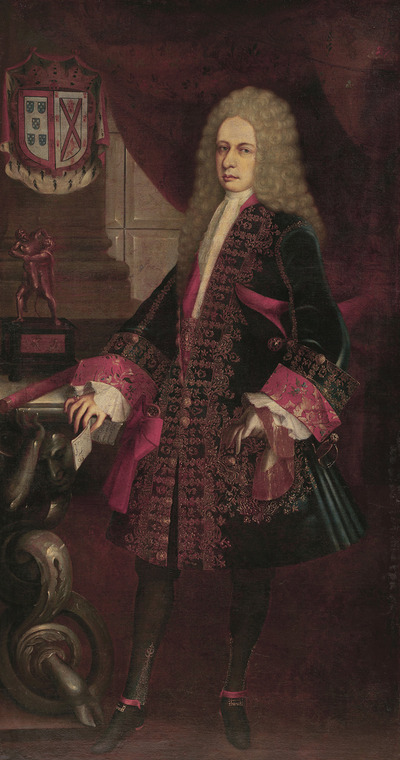
(Retrato del Virrey Alencastre Noroña y Silva, Duque de Linares, ca. 1711-1723.)
There was so much dark velvet, and so many little metallic buttons & buttonholes. Blood red linings were VERY fashionable in this era, no matter what the colour of the rest of the suit was.

(Johann Christoph Freiherr von Bartenstein by Martin van Meytens the Younger, 1730's.)
The slits on the front of the shirts are super low, they button only at the collar, and it's fashionable to leave most of the waistcoat unbuttoned so the shirt sticks out, as seen in the above portraits.

(Portrait of Anne Louis Goislard de Montsabert, Comte de Richbourg-le-Toureil, 1734.)
Waistcoats are very long, coats are very full, and the cuffs are huge. But the sleeves are on the shorter side to show off more of that shirt, and the ruffles if it has them! Creepy undead hands with long nails would sit so nicely under those ruffles.
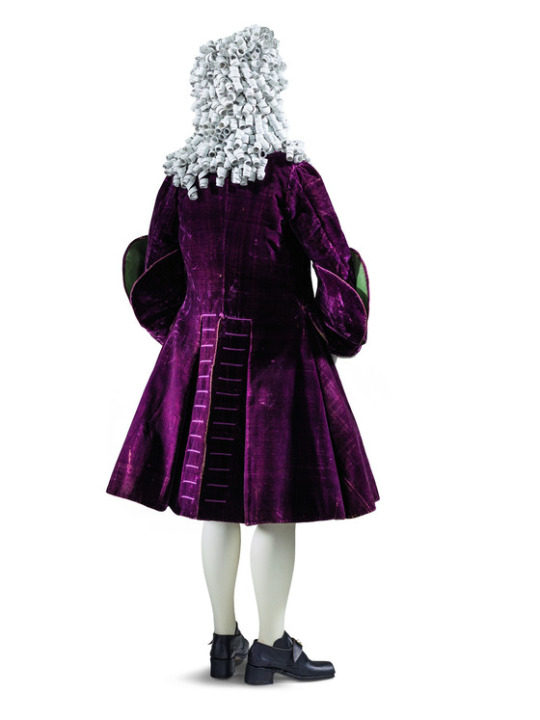
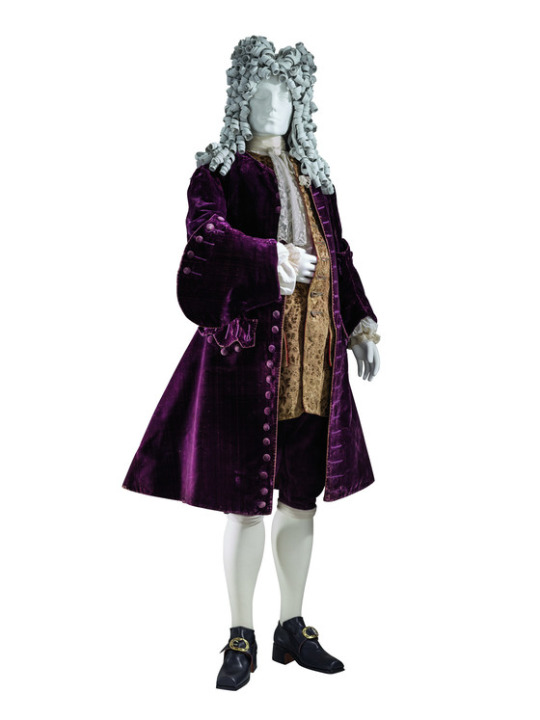
(1720's-30's, LACMA)
Embroidery designs are huge and chunky and often full of metallic threads, and the brocade designs even bigger.
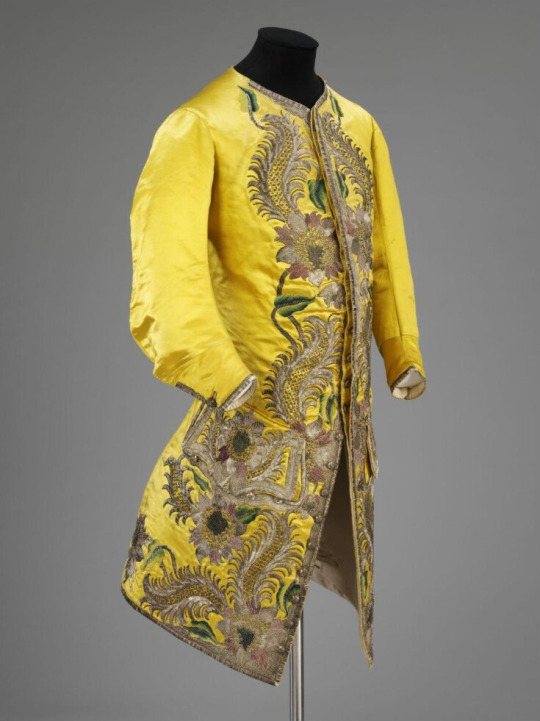
(1730's, V&A, metal and silk embroidery on silk satin.)
Sometimes they did this fun thing where the coat would have contrasting cuffs made from the same fabric as the waistcoat.
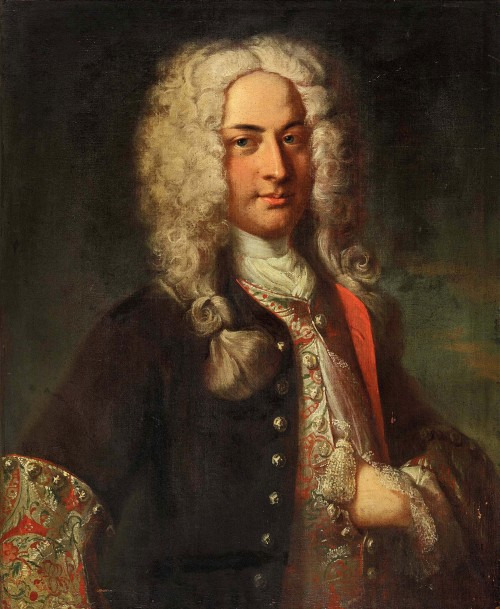
(Niklaus Sigmund Steiger by Johann Rudolf Huber, 1724.)
Tell me this look isn't positively made for vampires!
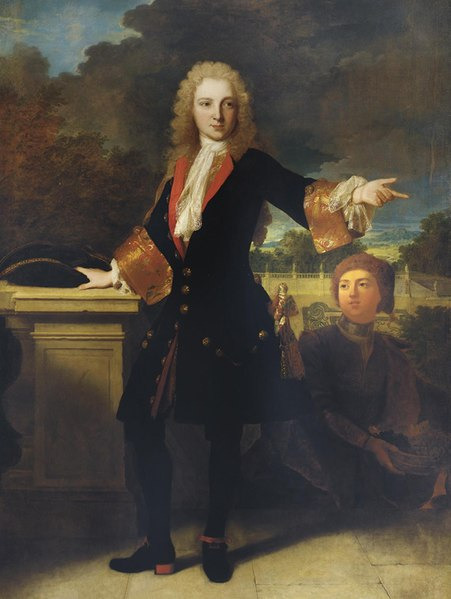
(Portrait of Jean-Baptiste de Roll-Montpellier, 1713.)
(Yeah I am cherry-picking mostly red and black examples for this post, and there are plenty of non-vampire-y looking images from this time, but you get the idea!)
And the wrappers (at-home robes) were also cut very large, and, if you could afford it, made with incredible brocades.
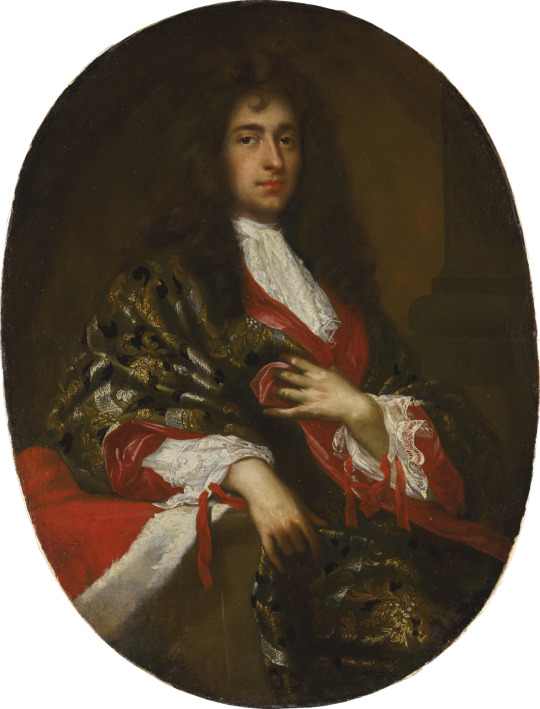
(Portrait of a nobleman by Giovanni Maria delle Piane, no date given but I'd guess maybe 1680's or 90's.)
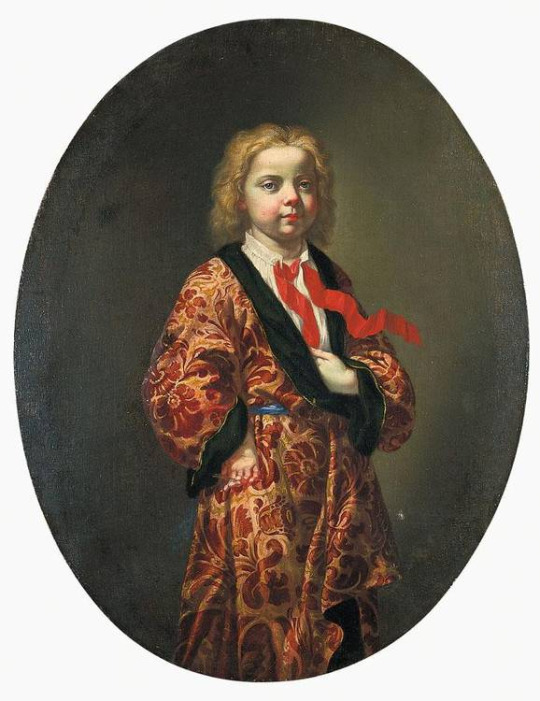
(Circle of Giovanni Maria delle Piane, no date given but I'd guess very late 17th or very early 18th century.)
Now that looks like a child who's been stuck at the same age for a hundred years if I ever saw one!
I don't know as much about the women's fashion from this era, but they had many equally large and elabourate things.

(1730's, Museo del Traje.)

(Don't believe The Met's shitty dating, this is a robe volante from probably the 1720's.)

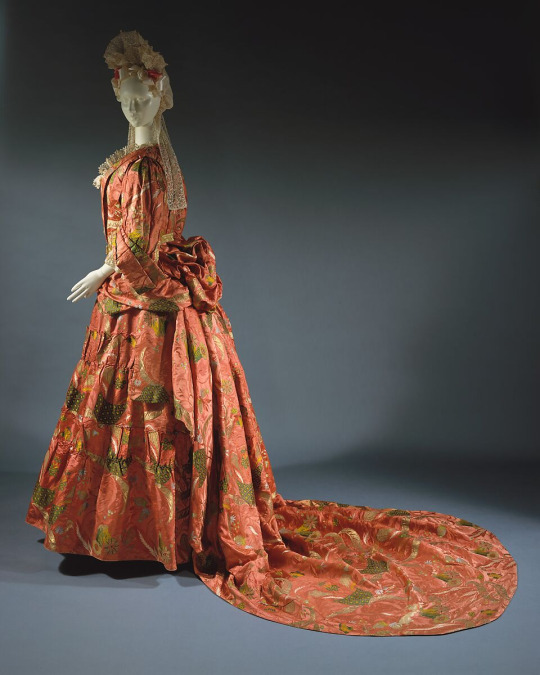
(Mantua, c. 1708, The Met. No idea why they had to be that specific when they get other things wrong by entire decades but ok.)

(Portrait of Duchess Colavit Piccolomini, 1690's.)

(Maria van Buttinga-van Berghuys by Hermannus Collenius, 1717.)
Sometimes they also had these cute little devil horn hair curls that came down on either side of the forehead.
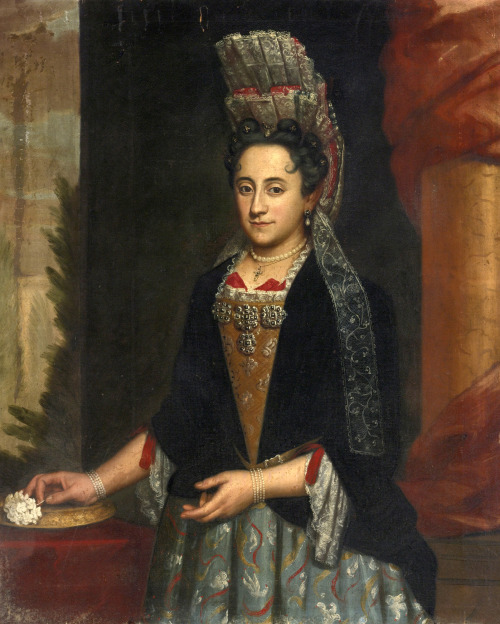
(Viago in drag Portrait of a lady, Italian School, c. 1690.)
Enough suave Victorian vampires, I want to see Baroque ones! With huge wigs and brocade coat cuffs so big they go past the elbow!
#long post#vampires#fashion#history#18th century#17th century#someday. SOMEDAY I will make a black/red/dark orange/metallic gold 1720's suit#I've got nearly all the materials I just need to:#1. Learn how to make early 18th century metallic thread buttons‚ preferably without having to buy the super expensive kind of thread#2. get a wig and style it appropriately
2K notes
·
View notes
Note
Hello! I'm trying to draw something for a friend. Both of our characters live in the late 1720s. They both have regular outfits, but I want to draw them wearing something fancy. My friend has described his character as having a very bad sense of fashion. I can't really picture what a bad outfit back then would look like. Do you?
Hello!
Well I haven't got all that much of a feel for what might have been considered a bad outfit back then, but there is one image that immediately comes to mind of someone who's very definitely badly dressed, and it's this guy. From the 4th panel of Hogarth's Marriage A la Mode (1743-45).

His individual garments look fine to me, but they're horribly mismatched! (And a bit old fashioned for the mid 40's.)
You'll note that the coat cuffs are made of a large brocade that contrasts with the main body of the coat, which was very popular in the first half of the century, but that style was meant to be worn with a matching waistcoat in the same brocade. Instead he's got a completely plain waistcoat that doesn't match at all.
And the breeches should match the main coat fabric, but his don't! The black and brown and beige clash awfully.
He's also got a lot more rings and a much bigger & sparklier earring than I've seen on any other guy from the era, which I speculate might have been tack and/or un-masculine, but I have no sources so don't quote me on that.
I just know that when 18th century guys are wearing rings in a portrait it's usually just one, and I've only ever seen simple little hoop earrings in a very few portraits. But again, emphasis on the "speculate" part of that sentence.
(And I've just noticed that the guy next to him has curling papers in his hair, which I think is probably also meant to make him look silly and not properly dressed. No idea what the opinion would have been about the folding fan dangling from the wrist of the next guy over, but it is intriguing. The very large beauty spot on his lip is probably meant to look bad though.)
That painting is a bit later than what you're asking about, but the style of matching cuffs & waistcoat was popular in the 20's too, so here are some examples of what it's supposed to look like.
A lot of them are very elaborate brocades paired with a solid dark coloured velvet, but sometimes it's a contrasting plain fabric with a ton of metal embroidery.
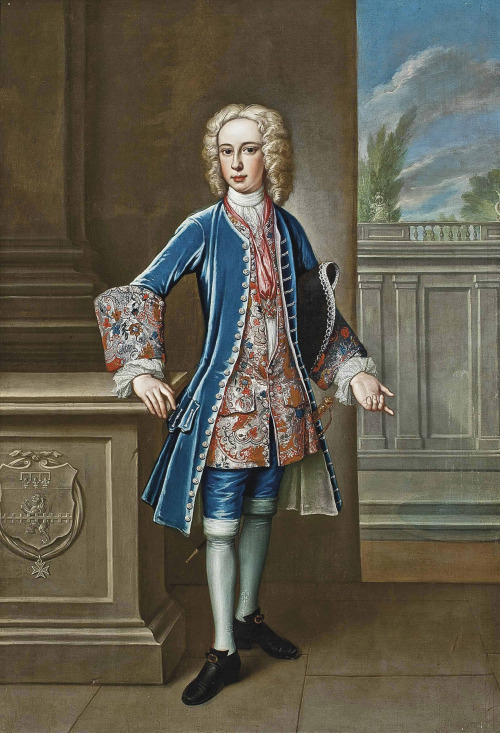
(1725)

(1723)

And an extant c. 1730's example from the NMS collection.
You might also look at 1710's images, because being a decade behind the current fashions would certainly make you badly dressed for the era.

(c. 1715-20)
So, I guess just put them in clashing parts of 2 or 3 different matched suits? (I am assuming you're asking about suits, since this ask was sent to me and I do not know very many things about dresses. Mostly only what I absorb from other costumers who post about it, and barely anyone does early 18th century.)
Please note that this does not apply to the 1780's-90's, fashion plates from those decades are incredibly full of clashing and mismatched suits. (Though it would probably still be bad to wear those ones on a very formal occasion.)
116 notes
·
View notes
Text

Suit
Fabric c.1725-1750
This man’s suit, comprising a coat, waistcoat and breeches, was acquired in Paris. It appears to have been made from an embroidered furnishing fabric, possibly a bed hanging, dating to the second quarter of the 18th Century, that has been turned into a theatrical or fancy dress outfit approximating the mid 18th Century in style. The bright yellow satin has been intricately pieced together, particularly on the waistcoat that, of the three garments, is the least authentic in cut. The sprays of large flowers tied together with ribbon bows, embroidered in couched chenille thread, have either been cut from the original fabric and stitched down or left in situ on the satin. A scattering of metal spangles is most dense on the front of the waistcoat, and the 18th Century metallic lace borders incorporate both very narrow strips of silver thread and metal thread wrapped around a silk core.
John Bright Collection
#suit#fashion history#historical fashion#1720s#1730s#1740s#yellow#embroidery#floral#satin#france#18th century#john bright collection
183 notes
·
View notes
Text
Needlebound Mitts
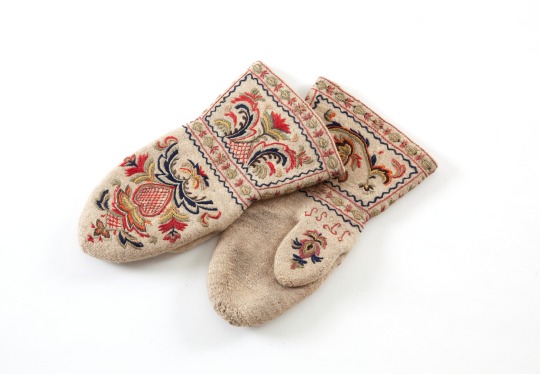
Pair of embroidered needlebound mitts, made in Heddal, Telemark in 1727.
Norsk Folkemuseum - Photographer Eva Brænd


Both needlebinding and embroidery are entirely in wool.
unknown if base colour is just white sheep or bleached in some way.
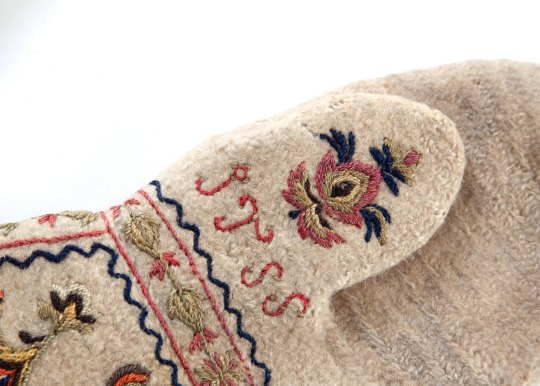
intitials "PT SS"
#needlebinding#nålebinding#embroidery#18th century#traditional clothing#fashion history#norway#folk costume#telemark#heddal#hitterdal#1700s fashion#1720s#1727#bunad
1K notes
·
View notes
Text
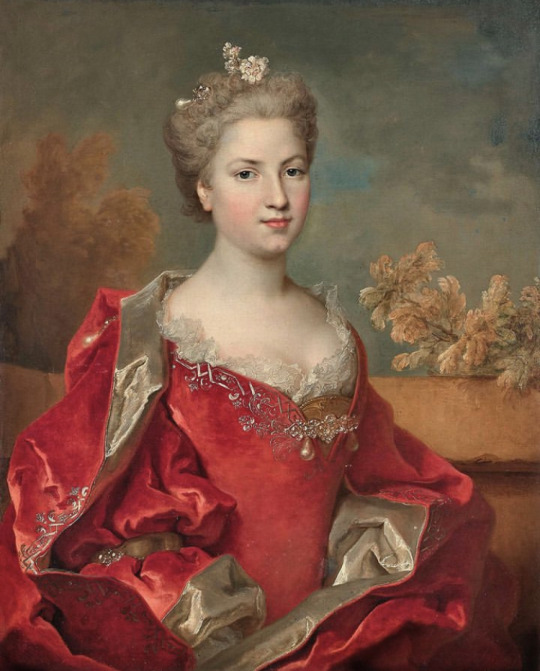
Nicolas de Largillière
203 notes
·
View notes
Text

Marie Leszcynska on Horseback by Jean-Baptiste Martin, 1725.
22 notes
·
View notes
Text
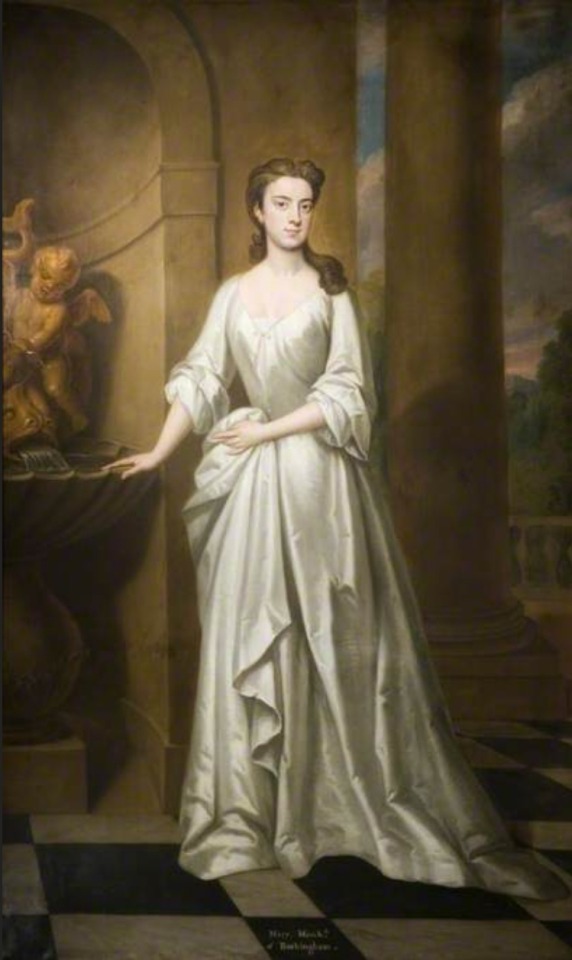

1. Mary Marchioness of Rockingham
2. Lady Mary Wortley Montagu
Artist: Godfrey Kneller
@battleofbunkerhill
9 notes
·
View notes
Text
A drawing I did of my ocs that took forever because I was screaming and crying about having like no 1720s fashion references
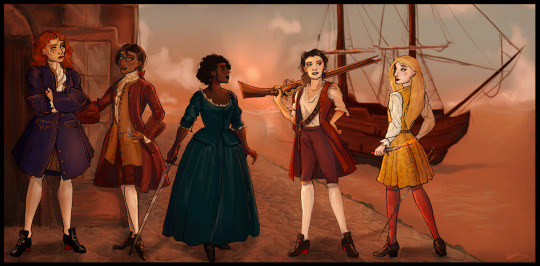
#character design#historical fashion#18th century#character illustration#18th century fashion#1720s#pirates#1720s fashion#historical#my art#look at the beautiful crusty image quality
12 notes
·
View notes
Text

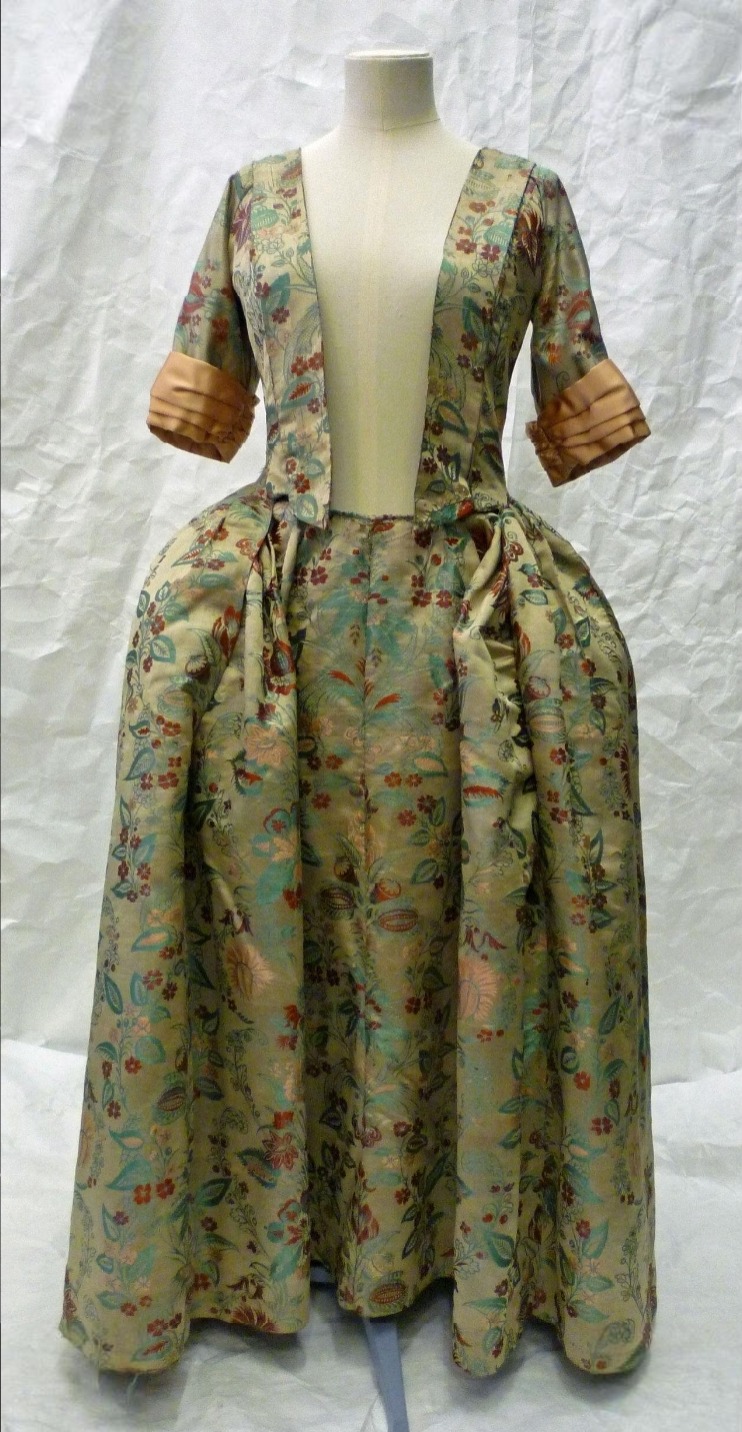

Woman's gown, 1775-85 of silk satin, oyster-coloured ground with green, coral, red, woven 1720-1725, English, altered 1870-1910
#18th century#18th century fashion#spitalfields silk#fashion history#historical fashion#1770s fashion#1720s#silk
97 notes
·
View notes
Text
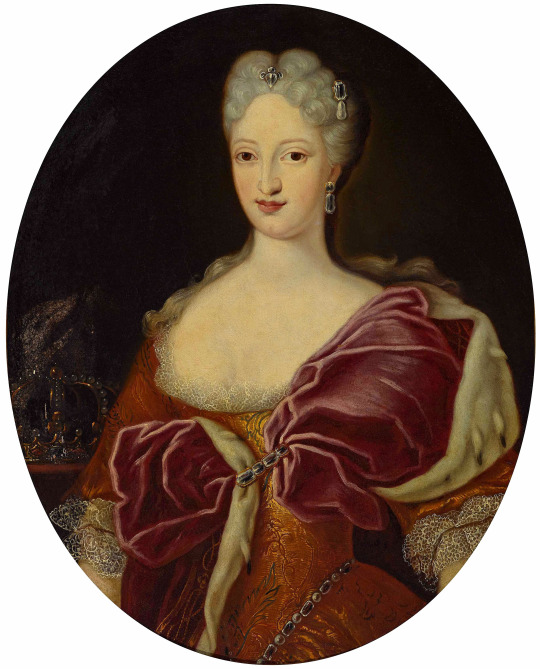
Anna Christine Luise von Pfalz-Sulzbach, Herzogin von Savoyen (1704-1723) by ? (auctioned by Neumeister). From Wikimedia; spots and cracks removed with Photoshop 2670X3307.
16 notes
·
View notes
Text
Researching as a Writer
Start Broad
begin with a list of more general topics and get specific as you go.
for example, research for a historical fantasy novel might follow a chain that looks like this:
life in the 1700s -> life in 1700s france -> 1700s french etiquette and lifestyle depending on class -> 1720s french fashion for middle and upper-middle class women.
starting with a general understanding of the topic you want to cover and narrowing down to specifics will make it easier to build on your knowledge as you go.
Think Critically
consider the source. if it doesn’t cite primary sources (for example, letters and photographs from a specific era and location), what sources does it cite? follow those sources if possible.
is the information reliable? is it provided by an educational institution or an expert on the subject?
who is the author? do they present any bias? what do they have to gain by promoting a specific mindset or conclusion? has any of their research been debunked?
Anecdotes
in general, anecdotal evidence is not sufficient for academic writing. luckily for you, this is a fiction writing page, and anecdotal evidence is usually fine!
work with a combination of scholarly sources and personal experience. if you’re trying to depict a specific health condition, you might consult medical sources about the technical details of the condition, as well as seeking firsthand accounts from people who have that condition.
remember that people are not monolithic! there are often forums online where people are more than happy to discuss their experiences; cross-consult these for common elements.
Lists
keep track of your sources!! if you ever need to consult something later on, it will be way easier to open a list of resources than go digging through your search history.
additionally, if you come across lists of sources compiled by other people, save those!! you are probably not the first person to research the specific topic you’re looking into, and there are entire websites dedicated to gathering research!
wordsnstuffblog.com/research has compilations of sources for everything from writing injuries to global period pieces by century.
Resources
if you can, check out your school or public library’s websites! they will often compile scholarly resources to access for free.
look for open access or open source sites like project gutenberg that archive and digitize historical documents and other works. scienceopen and the directory of open access journals are more of these. search using keywords!
keep an eye out for websites made specifically for educational purposes (those with .edu at the end of their addresses).
#🌿 writing#writing tips#writing advice#writing resources#i'm trying to compile some instagram posts on here for easier reference#writing research
893 notes
·
View notes
Text

'england: stomacher, c. 1720-40' in fashion + textiles in the international collections of the national gallery of victoria - robyn healy (2003)
65 notes
·
View notes
Text
One thing I tend to see really disparate takes on is how much of Stede's presentation is masculine or feminine, and I keep thinking about it. The tricky thing is that of course standards of masculinity have changed between the early eighteenth century and now, and at the same time this production is very much not one that's going to be historically accurate in such a way that it confuses the audience!
So, 1717 masculinity first.
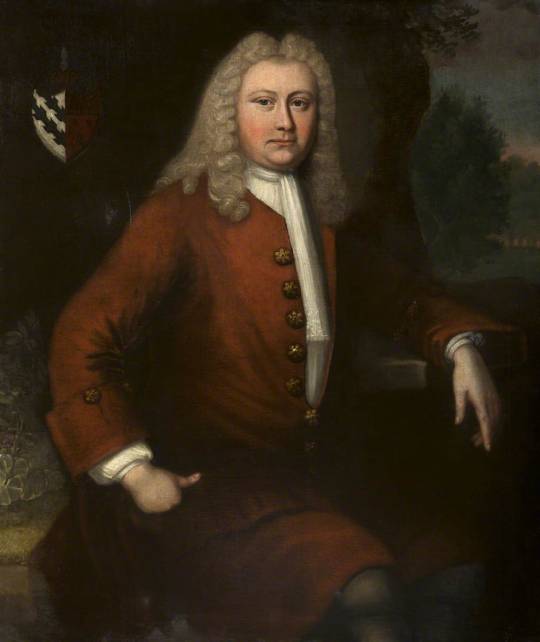

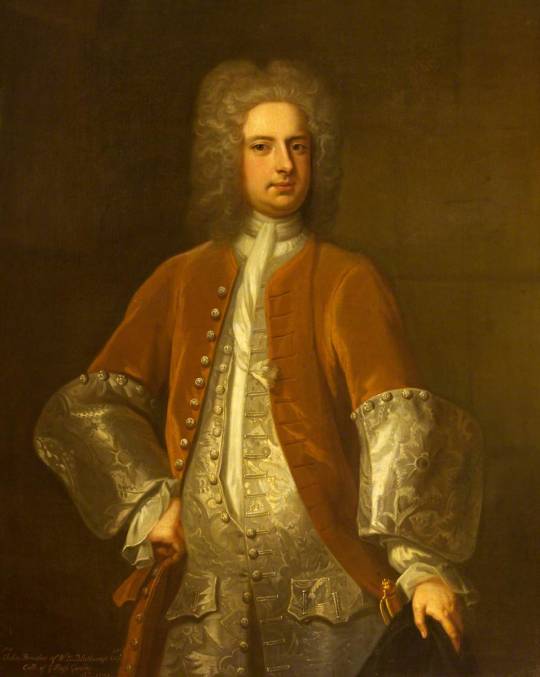

There's a stereotype that prior to Beau Brummell, there was no sense that men should be restrained in dress, but it's not true at all. Even in the 1710s and 1720s, English gentlemen were expected to have a certain soberness in their clothing - portraits show a preponderance of browns, as well as darker blues, greys, and occasionally reds; there's not that much trim, either, beyond buttons and occasionally a line of gold or silver braid. John Blathwayt is among the flashier, with a waistcoat and massive cuffs made out of a silvery damask - but attached to a brown silk (and really, grey-on-grey isn't that flamboyant). To a modern eye, the flowing wigs and stockinged calves relate to women's fashion, but both were symbols of masculinity in the period - women's hairstyles were more contained and natural, and their legs were covered with skirts.




The clothes Stede wears in the scenes set before he goes to sea generally reflect these norms. They're in darker tones, and cut fairly loose and not showing off his body. The orangey-brown anniversary outfit has the lightest colors and the closest fit, and it's still shades of brown and a pretty boxy shape. His cravat is often lacy, which really isn't very masculine for the period, but it's partially covered with a colored tie/secondary cravat - along with his lacy shirt cuffs, that's definitely something that can be read as a small expression of his style/queerness, which he's also half-concealing. In the betrothal scene, his cravat is actually a strangely rough fabric in a light grey, and I think it's tucked into his waistcoat so we can't actually see the ends.

I also want to note that the suit fabric really matches the upholstery in Stede's father's carriage. It's hard for me to not read this outfit as being chosen by Bonnet the elder to repress anything non-masculine about Stede, and also to show him as a possession, just like the carriage. On the other hand, the anniversary suit seems to be the brightest and most fitted, with a contrasting and I think floral-patterned waistcoat, and that was the scene where Stede tries to be more open than he's ever been with Mary about what he likes and wants.
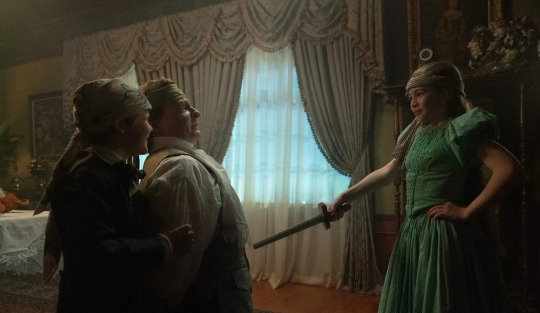
There's a similar thing in the scene where Mary tells Stede to play with Alma and Louis. He starts off reading and ignoring Mary in a plain dark green coat, the ends of his cravat hidden behind his book and the top of it largely covered with a green tie. Then we jump cut to him playing with the kids and he has taken off the plain coat to reveal a patterned, light blue waistcoat (short and fitted), and he's tied the green tie around his head to uncover the white cravat, which is also revealed to have intricate lacy ends. Likewise, when he runs away to sea, he wears a fairly yellow waistcoat, embroidered with flowers - the only embroidery we see on him in the flashbacks apart from a little bit on his nightshirt right before he runs away.
So, how does this compare to what he wears as Captain Bonnet? (Part II)
#ofmd#ofmd costuming#our flag means death#ofmd meta#our flag means death costuming#stede bonnet#18th century english masculinity
1K notes
·
View notes